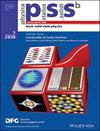通过纳米模板选择性面积生长技术在 Si (111) 基质上生长的井然有序的 InGaN/GaN 纳米柱阵列的红色发射率
IF 1.8
4区 物理与天体物理
Q3 PHYSICS, CONDENSED MATTER
引用次数: 0
摘要
本文在溅射沉积的 AlN/Si (111) 基底上制作了三角形晶格的纳米柱模板。纳米模板通过射频等离子体辅助分子束外延进行选择性面积生长,从而在纳米柱上生长出 GaN 纳米柱。通过插入迁移增强外延生长的氮化镓/氮化铝缓冲层,从而将氮化镓的极性调整为镓极性,获得了井然有序的均匀氮化镓纳米柱阵列。随后,随着生长时间(tg = 10-20 分钟)的增加,在氮化镓纳米柱顶部生长出块状 InGaN 有源层。在生长的初始阶段(tg = 10 分钟),低铟含量的 InGaN 生长在氮化镓纳米柱六面金字塔顶部的边缘。随着生长的进行,低铟含量的 InGaN 填满了边缘上 InGaN 之间的两侧,而高铟含量的 InGaN 则在 c 平面纳米柱的顶部迅速生长。高角度环形暗场扫描透射电子显微镜显示,在纳米柱顶部形成了一个 InGaN 内核,其上覆盖着一层低铟含量 InGaN 外壳。在 tg = 20 分钟时,光致发光光谱在 669 纳米处出现峰值,半最大值全宽为 51.7 纳米。因此,所提出的方法适用于在硅上生长红光发射有序的 InGaN/GaN 纳米柱阵列。本文章由计算机程序翻译,如有差异,请以英文原文为准。
Red Emission of Well‐Ordered InGaN/GaN Nanocolumn Arrays on Si (111) Substrates Grown via Nanotemplate Selective‐Area Growth
Herein, triangular‐lattice nanopillar templates are fabricated on sputter‐deposited AlN/Si (111) substrates. Nanotemplate selective‐area growth via radiofrequency‐plasma‐assisted molecular beam epitaxy is employed to grow GaN nanocolumns on the nanopillars. Well‐ordered uniform GaN nanocolumn arrays are obtained by inserting a migration‐enhanced‐epitaxy grown AlN/AlGaN buffer layer, thereby aligning the polarity of GaN to Ga‐polar. Subsequently, bulk InGaN active layers are grown on top of the GaN nanocolumns with increasing growth time (t g = 10–20 min). In the initial stage of growth (t g = 10 min), low‐In‐content InGaN grows on the edges of the six‐sided pyramidal top of the GaN nanocolumns. As the growth progresses, low‐In‐composition InGaN fills the sides between InGaN on the edges, while high‐In‐composition InGaN rapidly grows on the top of the c‐plane nanocolumns. High‐angle annular dark‐field scanning transmission electron microscopy reveals the formation of an InGaN core, covered with a low‐In‐composition InGaN shell, on the top of the nanocolumns. At t g = 20 min, the photoluminescence spectrum exhibits a peak at 669 nm with a full width at half maximum value of 51.7 nm. Thus, the proposed method is suitable for growing red‐light‐emitting well‐ordered InGaN/GaN nanocolumn arrays on Si.
求助全文
通过发布文献求助,成功后即可免费获取论文全文。
去求助
来源期刊
CiteScore
3.30
自引率
6.20%
发文量
321
审稿时长
2 months
期刊介绍:
physica status solidi is devoted to the thorough peer review and the rapid publication of new and important results in all fields of solid state and materials physics, from basic science to applications and devices. Being among the largest and most important international publications, the pss journals publish review articles, letters and original work as well as special issues and conference contributions.
physica status solidi b – basic solid state physics is devoted to topics such as theoretical and experimental investigations of the atomistic and electronic structure of solids in general, phase transitions, electronic and optical properties of low-dimensional, nano-scale, strongly correlated, or disordered systems, superconductivity, magnetism, ferroelectricity etc.

 求助内容:
求助内容: 应助结果提醒方式:
应助结果提醒方式:


